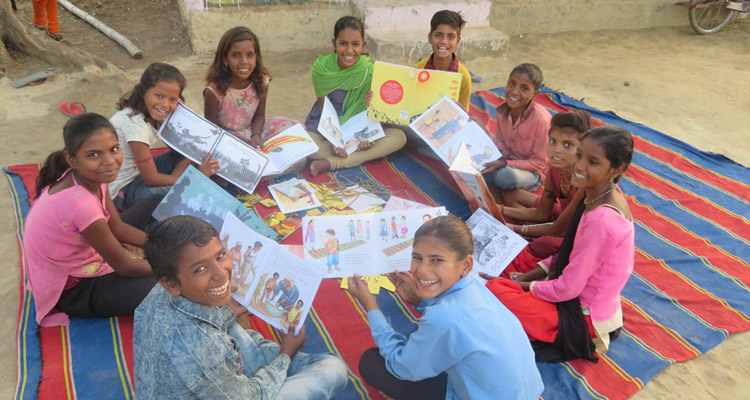
Children during group reading in a village
Akhil Bharatiya Samaj Sewa Sansthan (ABSSS) is making intervention in education sector in five villages suffering from deprivation, poverty, migration, water crisis and dacoit menace. At present 178 boys and girls are benefitting from this endeavour, supported by UPMA (Uttar Pradesh Mandal of America).
ABSSS started Bharat Mata Shiksha Sanskar Kendras in 1989 to improve the literacy rate in the patha region. Before 1986, the literacy rate among the 60,000 Kols residing in the area was a meagre two per cent, mainly because there were no schools and because the Kols were not enthusiastic about educating their children. Kol children were discriminated against in the available government schools, which provided education on lines unsuitable for these tribal children.
The Bharat Mata Shiksha Sanskar Kendras proved to be a fresh breeze in the realm of education as apart from holding regular classes and examinations, the kendras emphasised activities, such as morning processions, children’s assembly, exposure visits, organisation of national festivals, etc. Regular interaction with parents ensured their participation in the education of their children. The focus of education in the kendras is to make learning less complicated, more practical and in accordance with the needs of the learners.
Along with this, the government was pressurised to establish schools in the patha region, so sustained education can be ensured for Kol and other disadvantaged children. As a result, now almost each village in the region has a government primary school. It is another matter that almost all these schools are single teacher schools and teachers’ attendance is irregular.
Over 18,500 Kol and disadvantaged children have benefited from these efforts in education. Nearly 50 children, who studied in these schools, have completed their graduate and post-graduate studies.
ABSSS has established a full-fledged residential school for Kol dropout children, who can get education up to the 10th standard. Apart from regular studies, training in capacity building, leadership development, and vocational training (like tailoring, handlooms, crafts, computers, typing and electronics) is also imparted at this school.
